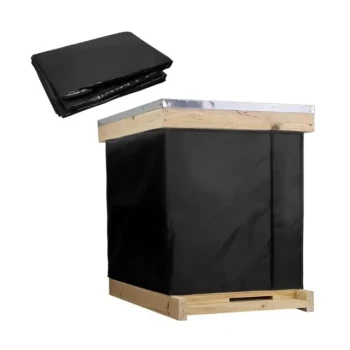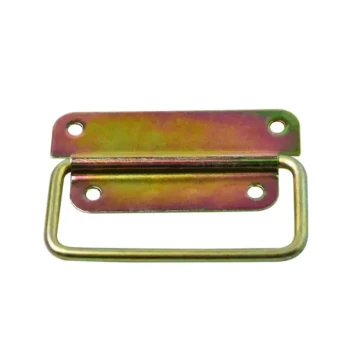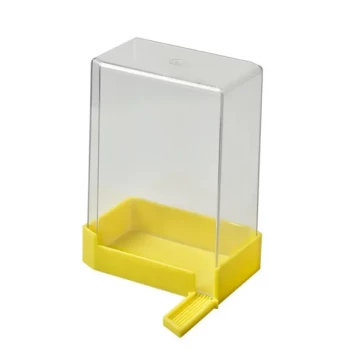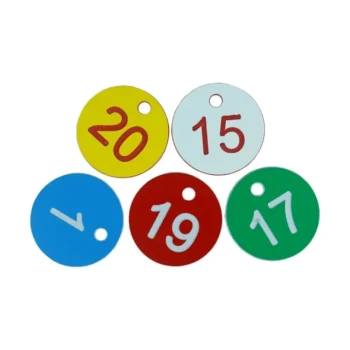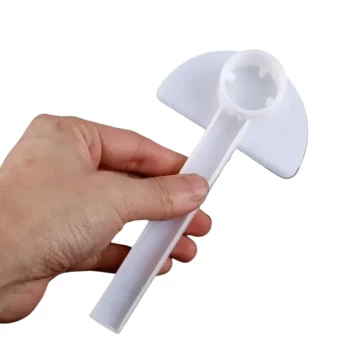In standard beekeeping practice, the deep rim of the inner cover should face upwards. This orientation is crucial for hive ventilation and insulation, creating a small air gap between the inner and outer covers. The shallow side of the cover rests just above the frames, maintaining proper bee space.
The orientation of your inner cover is not arbitrary; it's a tool for managing space and hive conditions. The "rim up" position is the default for general operation, while the "rim down" position is a temporary adjustment used specifically for feeding or treatments.
The Default Orientation: Rim Up
The standard, year-round position for the inner cover is with the deeper rim facing up, away from the bees. This configuration serves several critical functions for a healthy hive.
Creating an Insulating Air Gap
The space created by the upward-facing rim acts as a layer of dead air. This pocket provides valuable insulation, helping the colony stay cooler in the summer and warmer in the winter.
Providing an Upper Entrance
Most inner covers have a small notch on one side of the rim. When the rim is up, this notch creates a small upper entrance and exit for the bees. This helps reduce traffic at the main bottom entrance and improves air circulation, which is vital for dehydrating nectar into honey.
Ensuring a Proper Outer Cover Fit
The telescoping outer cover is designed to rest securely on the upward-facing rim of the inner cover. This creates a stable, weather-resistant cap for the hive, protecting it from rain and wind.
The Situational Orientation: Rim Down
Flipping the inner cover so the deep rim faces down into the hive is a specific, temporary adjustment made for a clear purpose. It is not the standard operating position.
Accommodating Supplemental Feed
This is the most common reason to reverse the inner cover. When placing solid or semi-solid feed like pollen patties, fondant, or winter sugar cakes directly on the top bars of the frames, you need extra space. Flipping the cover rim-down provides this clearance, preventing the feed and any bees on it from being crushed.
Applying Certain Hive Treatments
Similarly, some mite treatments or other medications come in strips or pads that are placed on top of the frames. Reversing the inner cover provides the necessary room for these applications.
Understanding the Trade-offs
Choosing an orientation has consequences, and using the "rim down" position incorrectly can cause problems.
Risk of Crushing Bees
When the inner cover is flipped rim-down, the flat surface sits very close to the top bars. This arrangement significantly reduces the bee space, increasing the likelihood of crushing bees when you place or remove the cover.
Obstructing the Upper Entrance
Placing the rim down often blocks or renders the notched upper entrance useless. This eliminates its benefits for ventilation and traffic reduction.
Compromising the Hive Seal
With the rim facing down, the outer telescoping cover may not fit as snugly. This can create a less stable seal, potentially allowing more moisture in or making the lid more susceptible to being blown off in a storm.
Making the Right Choice for Your Hive
Your decision should be based entirely on the immediate task at hand.
- If your primary focus is routine operation and hive health: Keep the inner cover rim facing up to provide insulation, ventilation, and a proper fit for the outer cover.
- If your primary focus is applying on-frame feed or treatments: Temporarily flip the inner cover rim facing down to create the necessary space and prevent crushing materials or bees.
Mastering this simple component's dual function empowers you to manage your hive’s internal environment with precision.
Summary Table:
| Orientation | Primary Use | Key Benefit | Key Drawback |
|---|---|---|---|
| Rim Up (Default) | Year-round hive operation | Provides insulation, ventilation, and a proper outer cover seal. | Not suitable for on-frame feeding/treatments. |
| Rim Down (Temporary) | Applying on-frame feed or treatments | Creates space to prevent crushing bees or materials. | Reduces bee space, blocks ventilation, compromises hive seal. |
Ensure your apiary operates at peak health and efficiency with the right equipment. Proper hive management starts with quality components. HONESTBEE supplies durable, precision-engineered beekeeping supplies and equipment—including inner covers designed for optimal function—to commercial apiaries and beekeeping equipment distributors through our wholesale-focused operations.
Contact HONESTBEE today to discuss your wholesale needs and equip your operation for success.
Visual Guide
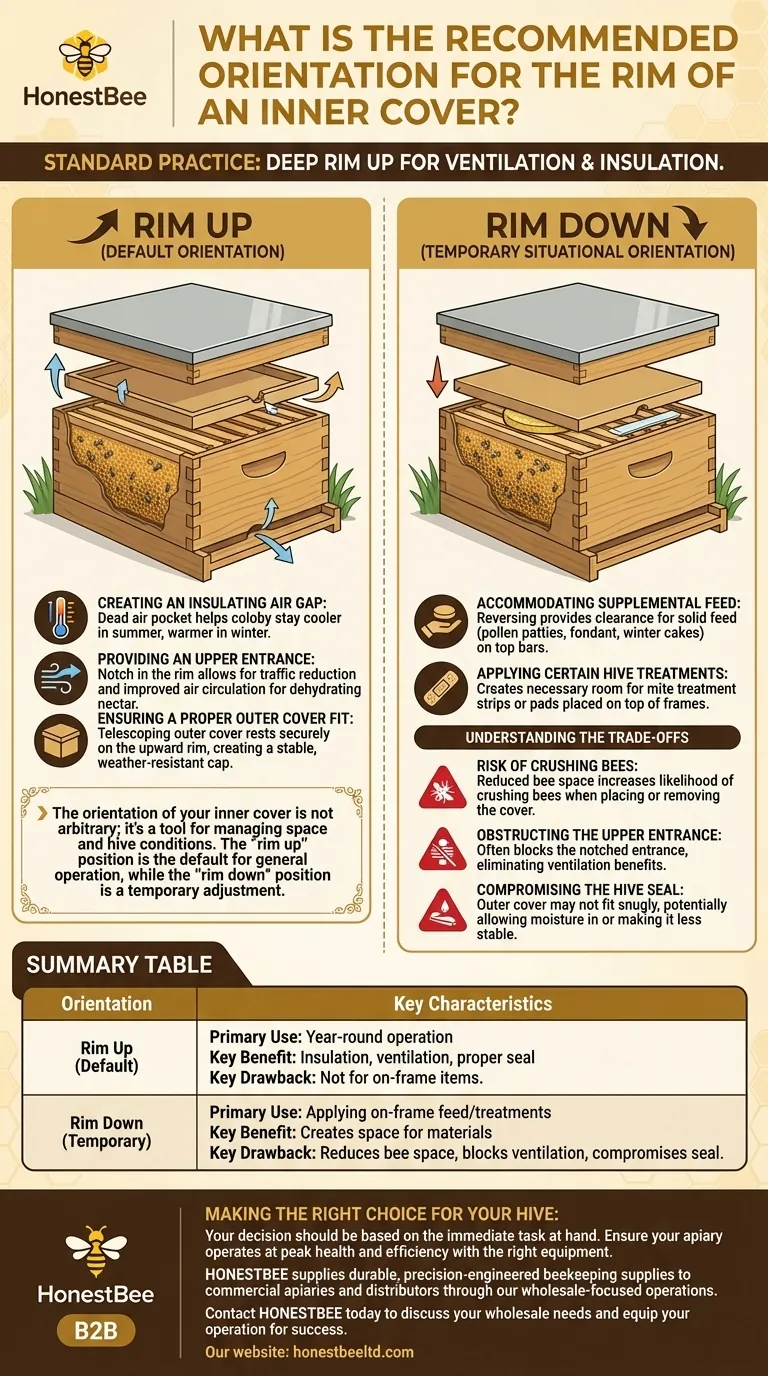
Related Products
- Inner Beehive Cover for Beekeeping Bee Hive Inner Cover
- Stainless Steel Round Beehive Air Vents for Ventilation
- Professional Insulated Winter Hive Wrap for Beekeeping
- Professional Drop-Style Hive Handles for Beekeeping
- Beehive Entrance Discs Plastic Bee Entrance Disc for Bee Hives
People Also Ask
- How is the inner cover used to promote ventilation? Master Hive Climate Control for Healthy Bees
- What are the advantages of using an inner cover in a beehive? Key Benefits for Hive Health & Beekeeper Efficiency
- What is the purpose of the inner cover in a beehive? A Key to Hive Health & Easy Management
- Why might beekeepers use an inner cover under the telescoping outer cover? Simplify Hive Management & Protect Your Colony
- What is an inner cover in a beehive and what are its features? A Key Tool for Hive Health & Management


